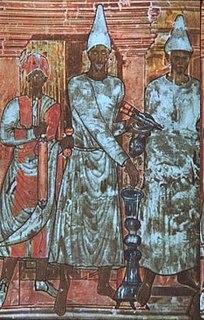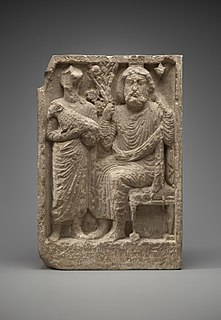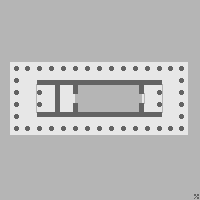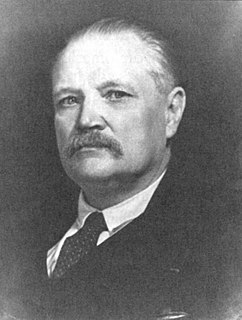
Dura-Europos, also spelled Dura-Europus, was a Hellenistic, Parthian and Roman border city built on an escarpment 90 metres above the right bank of the Euphrates river. It is located near the village of Salhiyé, in today's Syria. In 113 BC, Parthians conquered the city, and held it, with one brief Roman intermission, until 165 AD. Under Parthian rule, it became an important provincial administrative center. The Romans decisively captured Dura-Europos in 165 AD and greatly enlarged it as their easternmost stronghold in Mesopotamia, until it was captured by the Sasanian Empire after a siege in 256–57 AD. Its population was deported, and after it was abandoned, it was covered by sand and mud and disappeared from sight.

The Dura-Europos synagogue was an ancient synagogue uncovered at Dura-Europos, Syria, in 1932. The last phase of construction was dated by an Aramaic inscription to 244 CE, making it one of the oldest synagogues in the world. It was unique among the many ancient synagogues that have emerged from archaeological digs as the structure was preserved virtually intact, and it had extensive figurative wall-paintings, which came as a considerable surprise to scholars. These paintings are now displayed in the National Museum of Damascus.
Frank Edward Brown was a preeminent Mediterranean archaeologist.

The Temple of Antoninus and Faustina is an ancient Roman temple in Rome, which was later converted into a Roman Catholic church, the Chiesa di San Lorenzo in Miranda or simply "San Lorenzo in Miranda". It is located in the Forum Romanum, on the Via Sacra, opposite the Regia.

Mizrah is the Hebrew word for "east" and the direction that Jews in the Diaspora west of Israel face during prayer. Practically speaking, Jews would face the city of Jerusalem when praying, and those north, east, or south of Jerusalem face south, west, and north respectively.

The Temple of Hadrian was dedicated to the deified emperor Hadrian on the Campus Martius in Rome, Italy by his adoptive son and successor Antoninus Pius in 145 C.E. This temple was previously known as the Basilica of Neptune but has since been properly attributed as the Temple of Hadrian completed under Antoninus Pius. With one cella wall and eleven columns from the external colonnade surviving, the remains of the temple have been incorporated into a later building in the Piazza di Pietra, whereby its facade, alongside the architrave which was reconstructed later on, was incorporated into a 17th-century papal palace by Carlo Fontana, now occupied by the Borsa Italiana, Italy's main stock exchange. While only part of the structure remains, excavations and scholarship have provided us with information regarding its construction techniques and stylistic influences, helping us recreate the building dynamics and significance of the Temple of Hadrian in Imperial Rome.

Dura Parchment 24, designated as Uncial 0212, is a Greek uncial manuscript of the New Testament. The manuscript has been assigned to the 3rd century, palaeographically, though an earlier date cannot be excluded. It contains some unusual orthographic features, which have been found nowhere else.
C. Bradford Welles was an American Classicist and ancient historian, born in Old Saybrook, Connecticut. His academic career was at Yale University. He received a B.A. in 1924, a Ph.D. in 1928, became an Instructor in 1927, an Assistant Professor in 1931, an Associate Professor in 1939 and Professor in 1940. At his death he was Professor of Ancient History and Curator of the Yale Collection of Papyri. He was profoundly influenced by the great ancient historian Michael I. Rostovtzeff, who arrived at Yale in 1925.
The Feriale Duranum is a calendar of religious observances for a Roman military garrison at Dura-Europos on the Euphrates, Roman Syria, under the reign of Severus Alexander. The small papyrus roll was discovered among the documents of an auxiliary cohort, the Cohors XX Palmyrenorum, in the Temple of Azzanathkona. The calendar, written in Latin, is arranged in four columns, with some gaps. It offers important evidence for the religious life of the Roman military and the role of Imperial cult in promoting loyalty to the Roman emperor, and for the coexistence of Roman state religion and local religious traditions.
Count Robert du Mesnil du Buisson was a French historian, soldier, and archeologist. He was noted for his early use of geophysical survey for archaeology. He was son of Auguste, comte du Mesnil du Buisson and Berthe Roussel de Courcy, and married Jeanne Leclerc de Pulligny on 26 June 1923.

Parthian art was Iranian art made during the Parthian Empire from 247 BC to 224 AD, based in the Near East. It has a mixture of Persian and Hellenistic influences. For some time after the period of the Parthian Empire, art in its styles continued for some time. A typical feature of Parthian art is the frontality of the people shown. Even in narrative representations, the actors do not look at the object of their action, but at the viewer. These are features that anticipate the art of medieval Europe and Byzantium.
The Temple of the Gadde is a double temple in the Syrian city of Dura-Europos, located near the agora. It was dedicated to the protective deities of Dura-Europos and the nearby city of Palmyra. It was excavated between 1934 and January 1936 by the French/American expedition of Yale University, led by Michael Rostovtzeff.

The Temple of Bel, also known as the Temple of the Palmyrene gods, was located in Dura Europos, an ancient city on the Euphrates, in modern Syria. The temple was established in the first century BC and is celebrated primarily for its wall paintings. Despite the modern names of the structure, it is uncertain which gods were worshipped in the structure. Under Roman rule, the temple was dedicated to the Emperor Alexander Severus. In that period, the temple was located within the military camp of the XXth Palmyrene cohort.

The Temple of Zeus Kyrios stood in the city of Dura-Europos (Syria) and was probably built in the first century BC. It was excavated in 1934 by a joint French-American expedition.

The Temple of Adonis in Dura-Europos was discovered by a French-American expedition of Yale University led by Michael Rostovtzeff and was excavated between 1931 and 1934.

The Statue of Hercules was descovered in the Temple of Zeus Megistos in Dura-Europos during the 1935-1937 excavations undertaken by Yale University and the French Academy. The statue dates from the period of Roman rule at Dura-Europos. It is now in the possession of the Yale Art Gallery.

The Palace of the Dux Ripae was the largest and most important building in Dura-Europos during the period of Roman rule. According to the inscriptions, the Palace was erected under Elagabalus and it seems to have survived until the Sassanid conquest of Dura-Europos in AD 256.



















